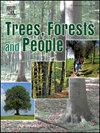Stand structure, regeneration potential and carbon storage across Moist Temperate Forest of Chopal forest division in Himachal Pradesh
IF 2.7
Q1 FORESTRY
引用次数: 0
Abstract
Himalayan moist temperate forests are one of the versatile and essential ecosystems for studying the biodiversity and carbon storage potential in Indian Himalayas. Therefore, a comprehensive assessment across eight sub-forest types (i.e. Ban oak forest, Moru oak forest, Moist deodar forest, Western mixed coniferous forest, Moist temperate deciduous forest, Low level blue pine forest, Kharsu oak forest and Western Himalayan upper oak fir forest) of Himalayan moist temperate forest was carried out in Chopal forest division of Himachal Pradesh to examine the species diversity, stand structure, biomass, carbon storage, regeneration status and site characteristics. The study revealed the highest tree density in the Moist deodar forest (338.10 number ha-1) followed by Western Himalayan upper oak fir forest whereas, the lowest was recorded in Moist temperate deciduous forest. The basal area was highest in the Ban oak forest (61.02 m2 ha-1). Among vegetation indices Shannon-Wiener index (H) was highest in Western Himalayan upper oak fir forest (1.36) and lowest was in Ban oak forest (0.56). The Simpson's dominance index (D) was highest in Ban oak forest (0.63) and lowest was in Kharsu oak forest (0.25). Margalef's species richness (Dmg) was highest in the Moist temperate deciduous forest (1.38) and lowest in the Ban oak forest (0.29). Further, the stand structure analysis in all the sub-forest types revealed the highest number of trees in the mid-diameter classed i.e. 30–40 cm and 40–50 cm except for Ban oak forest, which had a greater number of trees in 80–90 cm diameter class. The total biomass (570.84 Mg ha-1) and total carbon density (354.91 C Mg ha-1) were found highest in Moist deodar forest whereas, the lowest was found in Moist temperate forest. The soil carbon density was highest (90.74 Mg C ha-1) in Western Himalayan upper oak fir forest and lowest in Western mixed coniferous forest. The Moist deodar forest showed the satisfactory regeneration status among differs forest types. The soil physio-chemical properties such as soil pH, electrical conductivity and bulk density were highest in Moist temperate deciduous forest whereas, the organic carbon, available nitrogen, phosphorus and potassium were highest in Western Himalayan upper oak fir forest. Among all forest types, the Moist deodar forest showed the highest carbon storage capacity, whereas tree diversity and soil carbon density were highest in the Western Himalayan upper oak fir forest. Therefore, considering the current scenario of climate change, these two sub-forest types showed greater potential, which further needs the implication of sustainable management plans for the conservation of biodiversity and livelihood security.
喜马偕尔邦Chopal林分区湿温带林分结构、更新潜力和碳储量
喜马拉雅湿温带森林是研究印度喜马拉雅地区生物多样性和碳储存潜力的重要生态系统之一。因此,综合评估在8个sub-forest类型(例如禁止橡树林,Moru橡树森林,潮湿的森林喜马拉雅雪杉,西方混合针叶林,湿润温带落叶林,低水平蓝色的松林,Kharsu橡树林和西喜马拉雅上橡树冷杉林)喜马拉雅的湿润的温带森林在喜马偕尔邦Chopal森林部门进行检查物种多样性,站结构、生物量、碳储存,再生现状及场地特点。研究结果表明,树密度最高的是湿阔叶林(338.10 number ha-1),其次是西喜马拉雅上栎树冷杉林,最低的是湿温带落叶林。其中基底面积最大的是班栎林(61.02 m2 ha-1)。植被指数中,西喜马拉雅上冷杉林的Shannon-Wiener指数(H)最高,为1.36,班栎林最低,为0.56。辛普森优势度指数(D)以班栎林最高(0.63),哈尔苏栎林最低(0.25)。湿温带阔叶林的物种丰富度(Dmg)最高,为1.38,而斑栎林最低,为0.29。此外,所有亚林类型的林分结构分析均显示,除班栎林的80 ~ 90 cm林分数量较多外,30 ~ 40 cm林分和40 ~ 50 cm林分的林分数量最多。总生物量(570.84 Mg ha-1)和总碳密度(354.91 C Mg ha-1)以湿阔叶林最高,湿温带林最低。土壤碳密度以西喜马拉雅上栎树冷杉林最高(90.74 Mg C ha-1),西部混交林最低。在不同的森林类型中,湿杉木林表现出满意的更新状况。湿温带阔叶林土壤pH值、电导率和容重等理化性质最高,西喜马拉雅上游栎树冷杉林土壤有机碳、速效氮、速效磷、速效钾含量最高。在所有森林类型中,湿杉木林的碳储量最高,而树木多样性和土壤碳密度则以西喜马拉雅上游杉木林最高。因此,考虑到目前的气候变化情景,这两种亚森林类型显示出更大的潜力,进一步需要对生物多样性保护和生计安全的可持续管理计划进行暗示。
本文章由计算机程序翻译,如有差异,请以英文原文为准。
求助全文
约1分钟内获得全文
求助全文
来源期刊

Trees, Forests and People
Economics, Econometrics and Finance-Economics, Econometrics and Finance (miscellaneous)
CiteScore
4.30
自引率
7.40%
发文量
172
审稿时长
56 days
 求助内容:
求助内容: 应助结果提醒方式:
应助结果提醒方式:


